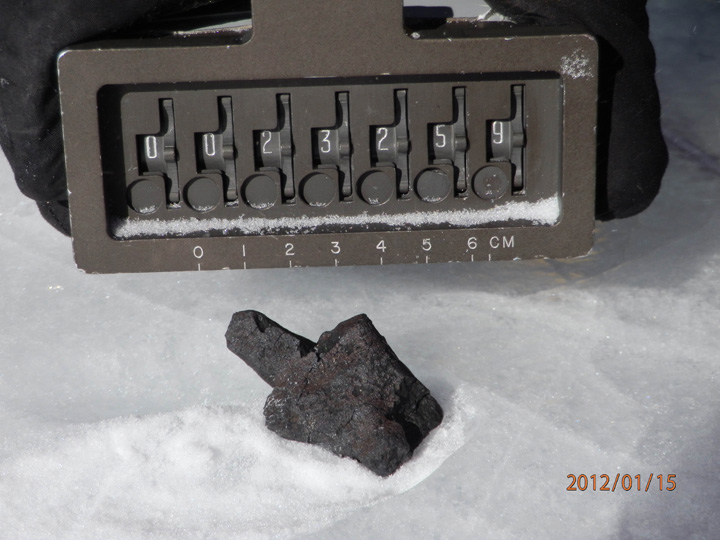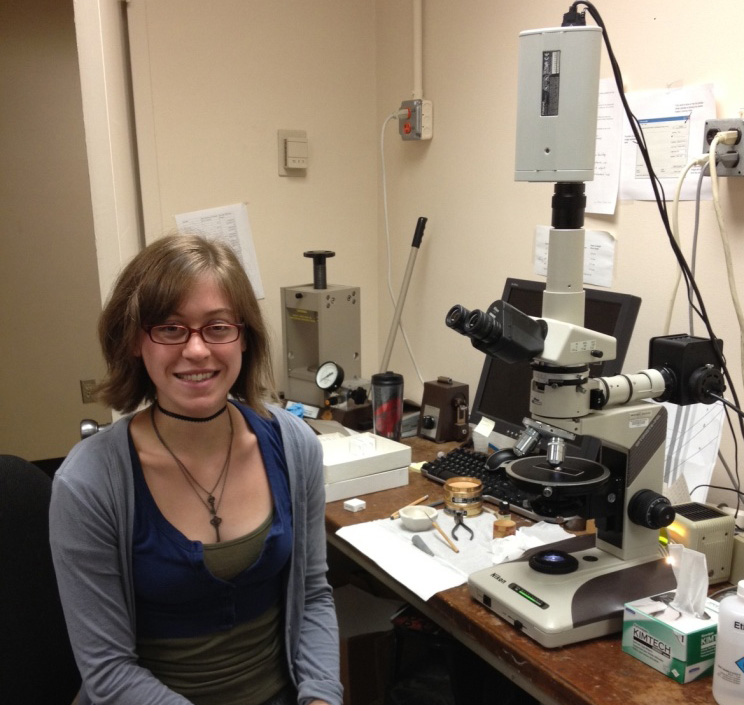Program News
Curator Comments
Kevin Righter, NASA-JSC
This newsletter reports 278 new meteorites from the 2009 and 2011 ANSMET seasons from the Allan Hills (ALH) and Miller Range (MIL). The new samples include 69 new carbonaceous chondrites (56 CO, 6 CM, 2 CR, 2 CV, 2 CK, and 1 CH), 1 R chondrites (hornblende-bearing!), one each of L3.4 and L3.8 chondrites, and one each of H and LL chondrite impact melts. The new R chondrite is similar in its mineralogy to the unusual hornblende- and biotite-bearing R chondrites LAP 04840 (and pairs), but the texture is different, with chondrules not as easily discernable.
Among the new achondrites are 1 lodranite, 1 ureilite, 1 metamorphosed mesosiderite clast, 10 HED meteorites, and 1 ungrouped achondrite. The ungrouped achondrite, MIL090405, is olivine-rich, and similar to 5 previously announced MIL samples that have been classified as “ungrouped achondrite” or “ureilite” (MIL 090340, 090356, 090206, 090805, 090963). They are all very similar, and may instead represent material that is related to brachinites (e.g., Warren and Rubin, 2012, LPSC abstract #2528; Goodrich et al., 2012, MetSoc abstract #5272).
The meteorite collection received 36 requests for the Spring 2012 MWG meeting; the sample chips have been prepared and sent out for most PIs (unless you had a very large number of samples approved for allocation, in which case you may still be waiting on several samples), and there are still thin sections being prepared.
Reclassification of several samples
Four previously announced MIL samples that have been classified as “ureilite” (MIL 090340, 090356, 090206, 090805), are being reclassified here to “ungrouped achondrite”. They are all very similar to two additional samples — MIL 090963 and MIL 090405 — and may instead represent 6 meteorites that are related to brachinites, based on Ca and Cr content of the olivines, O-isotopes, and olivine rim mineralogy (e.g., Warren and Rubin, 2012, LPSC abstract #2528; Goodrich et al., 2012, MetSoc abstract #5272). Although these meteorites may be related to brachinites, they are not true brachinites and so the classification “ungrouped achondrite” will be used until a further change is necessary. We specifically want to call attention to the fact that they are not ureilites so that researchers will not mistakenly request them as such. Concomitantly, we feel that researchers who are interested in brachinites may find these samples of interest and may not have noticed them previously due to the ureilite label.
New rules for PIs: loan agreements and annual inventories
In November of 2011, the Office of the Inspector General released an audit report for the JSC Astromaterials collections, with several recommendations relating to the Antarctic meteorite collection. One of the recommendations was to initiate loan agreements with scientists receiving samples from the collection. A second recommendation was to carry out an annual inventory with PIs who have borrowed samples from the collection. Starting in late 2012 or early 2013, we will be requiring all PIs to have a loan agreement completed with JSC, and annual inventories will be required. Lack of response to our inventory requests, or inability to account for samples may lead to a PI being denied loan of additional materials from the collection. Later this year we will send out information about how to establish loan agreements and annual inventories. This note is just a warning that these major changes will be starting soon.
Classification of 2009-2010 ANSMET season meteorites completed
With this newsletter, JSC and the Smithsonian have completed the characterization of the 2009-2010 field season samples — 1005 meteorites from the Miller Range (MIL) and 11 meteorites from the Allan Hills (ALH). The great diversity of meteorites recovered from the Miller Range continues. Among the achondrites, this season included 4 lunar meteorites, 3 additional pieces of the MIL 03346 nakhlite, a lodranite, 3 ureilites, 20 HEDs, 3 pallasites, 2 IVA irons, a mesosiderite, and 6 ungrouped achondrites that appear to have an affinity to brachinites. Among the chondrites are one each of the rare CB and CH chondrites, 4 CKs, 16 CMs, a huge number of CO3 (110 different specimens), 3 CRs, 19 CVs, and a highly unusual hornblende–bearing R chondrite. In addition, there were 5 enstatite chondrites, 2 enstatite chondrite impact melts, and 4 other ordinary chondrite impact melts. This great diversity of materials is helping to understand processes on the Moon and Mars as well as on asteroids and in primitive solar system materials, including some one–of–a–kind samples such as the ungrouped achondrites and R and CH chondrites.
2011-2012 ANSMET Field Season Report
Ralph Harvey, Principal Investigator, ANSMET
As we approach the 2012-2013 field season, ANSMET has passed one milestone and is approaching another challenging season. As mentioned in the spring newsletter, our searches at the Miller Range last season brought the total number of specimens recovered by ANSMET to slightly over 20,000 (20,002 by my count). Ignoring all the many ways that number can be inaccurate (pairing, as-yet-examined terrestrial “meteowrongs”, etc.), it was a goal we’ve held for a long time. Yet it didn’t actually occur to us to look specifically at the 20,000th specimen itself until a few weeks after we got back from the ice. The field notes identified the lucky specimen as field number 23259, presumed to be a carbonaceous chondrite, described in this newsletter and now forever known as MIL 11111 (a number chosen to commemorate its special status). The meteorite itself, however, doesn’t seem to appreciate the honor; as the picture below shows, it expressed its opinion of our recovery efforts using a hand-gesture familiar to anyone who has driven on US roads.

MIL 11111
I’m trying to have a little more patience and understanding than that meteorite displays, given that the field season ahead promises to test our patience and planning efforts. As we have done in many recent seasons we will deploy two field parties, but this time both will be visiting several icefields. The 8–person ‘systematic” field party, dedicated to recoveries from icefields known to harbor significant meteorite concentrations, will land near the Otway Massif. Following that, the team will traverse to icefields at Larkman Nunatak and in the Grosvenor Mountains, where previous searches have yielded about 1200 specimens including many of unique composition. The 4-person “recon” field party, dedicated to the exploration of new or poorly understood icefields, will be visiting 6-8 different sites. First we’ll explore a number of promising sites in the Robison Glacier region (not far from Graves Nunatak). After about 3 weeks the team will move north along the Transantarctics to the Amundsen Glacier region, visited briefly in 1995 and where other interesting icefield await. With both teams moving frequently, our results will be heavily dependent on the weather and availability of logistical support. And with a new polar support contractor, new funding paradigms on ANSMET’s horizons and other issues, it’s definitely rush hour around here. You can follow our progress through our daily weblog, available on the ANSMET website starting in late November.
Report from the Smithsonian
Cari Corrigan, Geologist (Dept. of Mineral Sci.)

Sheri Singerling
This newsletter announces the classification of 278 meteorites from the Allan Hills (2009 season) and Miller Range (2009 and 2011 seasons) field areas. Since the last newsletter our thin section preparator, Tim Gooding has started and returned full force to making fantastic meteorite thin sections. We really appreciate having him back in the lab. Sadly, our contractor of the past two years, Nicole Lunning (MSc, UC Davis, 2009), is departing the Smithsonian for the University of Tennessee. She will begin a Ph.D. program working with Hap McSween on meteorites. While we will miss her and wish her very well, we know she'll be in good hands and since she was converted to the field of meteoritics, we don't have to say goodbye! Sheri Singerling, (MSc, U of Tennessee, 2012) has been hired to fill the slot left vacant by Nicole and they have been working hard together the past week to ensure a smooth transition.
*CORRECTION OF CLASSIFICATIONS:
MIL 090937 is a metamorphosed mesosiderite. MIL 090936 is an LL5 (these were switched), classified by oil immersion. MIL 090937 was originally reported in the Spring 2012 (35,1) newsletter.
